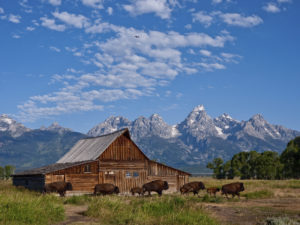
Vast plains and the Rocky Mountains paint the landscape of Wyoming, the Cowboy State. Its famed Yellowstone National Park, a nearly 3,500 square mile wilderness area, is home to hundreds of animal species (i.e., bears, wolves, bison, elk and antelope), dramatic canyons, alpine rivers, lush forests, hot springs and gushing geysers, its most famous geyser being Old Faithful. Yellowstone was the nation’s first national park and the first national monument was Devil’s Tower. Known for its backcountry skiing areas, forested trails and Snake River is Grand Teton National Park.
Just a few of the ways to explore Wyoming’s natural lands is to enjoy a sightseeing tour, soak in a hot spring or watch the wildlife. Yellowstone Lake offers plentiful fishing and boating during the warmer months.
Due to its sparse population, Wyoming lacks any major professional sports teams. However, college (e.g., the University of Wyoming) and high school sports are popular in the state. Rodeos and Rugby are also popular sporting events in Wyoming.
Business Climate
Agriculture is an important part of Wyoming’s culture and lifestyle. Some of the main agricultural commodities produced in the state include livestock (beef), hay, sugar beets, grain (wheat and barley), and wool.
An essential part of Wyoming’s economy is its mineral and energy production. Their mineral commodities include coal, natural gas, coalbed methane, crude oil, uranium and trona. Trona is a mineral used for manufacturing glass, paper, soaps, baking soda, water softeners and pharmaceuticals. Wyoming possesses the world’s largest known reserve of trona.
Due to Wyoming’s geography and high-altitude, the potential for wind power in the state is one of the highest in the country. The Chokecherry and Sierra Madre Wind Energy Project is the largest commercial wind generation facility under development in North America. Carbon County, in the Southeastern part of the state, is home to the largest proposed wind farm in the U.S. Cheyenne, the state capital, also resides in the Southeastern portion of the state, which as of 2010 had a population of 91,738 people. This makes it the 354th most populous metropolitan area in the U.S.
In 2002, more than 6 million people visited Wyoming’s national parks and monuments. Key tourist attractions in Wyoming include Grand Teton National Park, Yellowstone National Park, Devils Tower National Monument, Independence Rock and Fossil Butte National Monument.
Tax Climate
Wyoming levies no individual income tax, joining just six other states with the same policy: Alaska, Florida, Nevada, South Dakota, Texas, and Washington. Similarly like Nevada, Ohio, South Dakota, Texas and Washington, Wyoming also levies no corporate income tax. So, you may wonder, how do they pay for government services?
Wyoming levies a 4% general sales or use tax on consumers, substantially below the national median of 5.95%. The average local sales tax rate is an additional 1.4%. Wyoming’s state and local governments collect $1,489 per person in general sales taxes and $285 per person in excise taxes, for a combined figure of $1,774, which ranks 11th highest nationally. Wyoming’s gasoline tax stands at 24 cents per gallon, 32nd highest nationally, while its cigarette tax stands at $0.60, 41st highest nationally.
Wyoming’s state and local governments collected approximately $2,173 per person in property taxes in 2013, which ranks 7th highest nationally.
These tax rates make living, working and doing business in Wyoming very attractive.
Tax Incentives and Credits
A key benefit of doing business in Wyoming is the lack of corporate or personal income taxes. Besides allowing business owners to enjoy higher earnings, the lack of an individual income tax contributes to a lower cost of labor in the state. As a result, Wyoming offers few formal tax incentives.
Although business tax credits are very limited, two that are noteworthy are:
WyoRECs Renewable Energy Credit Discount Program
WyoRECS is a partnership that was formed in 2013 between the Wyoming Business Council and Powder River Energy Corporation to offer discounted renewable energy credits (RECs) to companies that are interested in taking advantage of green energy to power their growing Wyoming operations.
Workforce Training Grants
The Workforce Development Training Fund (WDTF) was created by the 1997 Wyoming Legislature and assists new and existing industries in the state with the training needs of newly hired or current employees.
For more information on Wyoming Tax Credits, please visit the Wyoming Business Council. Then call us at Miles Consulting Group to see how we can make these ideas work for you. 🙂
Random Facts
- Wyoming is the 10th largest state by area in the U.S., yet the least populous state.
- The state has 32 named islands. Most of them are located in Jackson Lake, Yellowstone Lake and the Green River.
- The Continental Divide spans north-south across the central portion of the state. Rivers east of the divide drain into the Missouri River Basin and eventually into the Gulf of Mexico.
- Wyoming is one of only two states, the other being South Dakota, in the 48 contiguous states, not served by Amtrak.



















